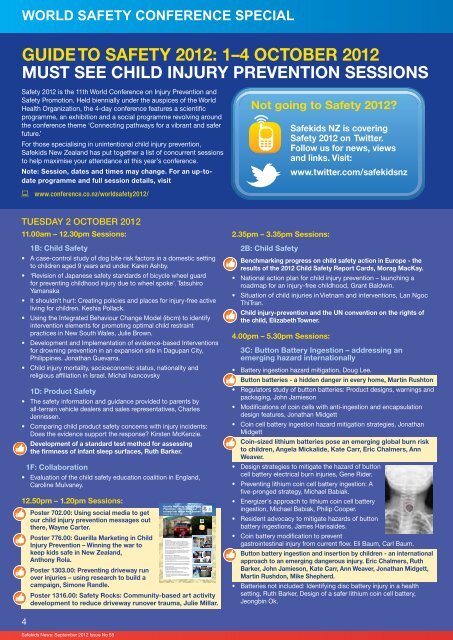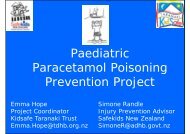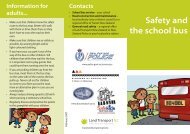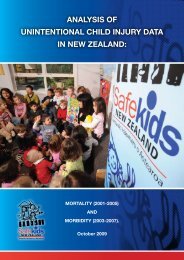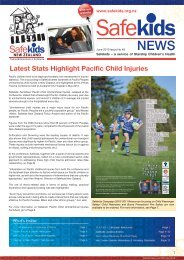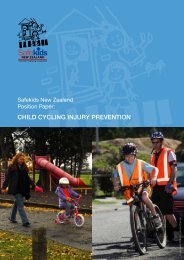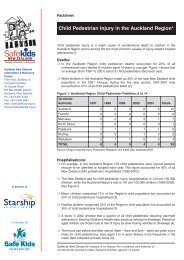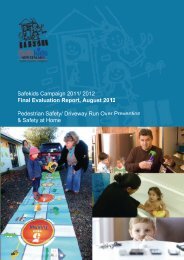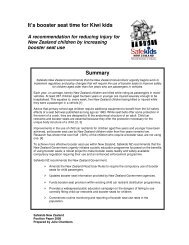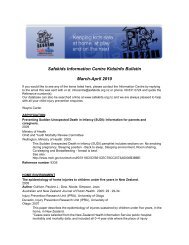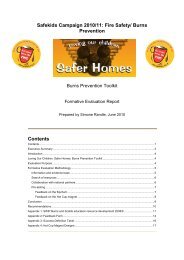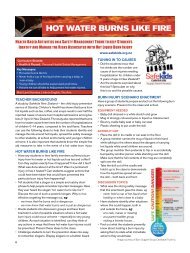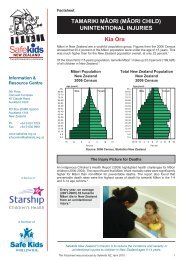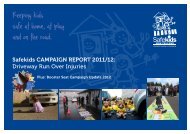MUST SEE CHILD INJURY PREVENTION SESSIONS! - Safekids
MUST SEE CHILD INJURY PREVENTION SESSIONS! - Safekids
MUST SEE CHILD INJURY PREVENTION SESSIONS! - Safekids
Create successful ePaper yourself
Turn your PDF publications into a flip-book with our unique Google optimized e-Paper software.
Scan this QR Code<br />
or visit www.<br />
mysafekids.org.<br />
nz to watch some<br />
of <strong>Safekids</strong> New<br />
Zealand’s Guerilla<br />
Marketing ideas.<br />
Background<br />
Unintentional childhood injury is a serious but neglected public<br />
health issue in New Zealand. The casualties are high (two children<br />
killed every week and 8,184 children hospitalised every year), and the<br />
economic burden is immense – it cost the government NZ$146.6<br />
million in child injury claims during the 2007/2008 financial year.<br />
Unintentional childhood injury is not seen as a priority issue, has few<br />
allies, and receives little support or recognition.<br />
The injury prevention workforce is facing an uphill battle, and <strong>Safekids</strong>,<br />
the child injury prevention service for New Zealand, is forced to<br />
pursue conventional goals with unconventional methods – using<br />
Guerrilla Marketing tactics.<br />
What is Guerrilla Marketing?<br />
Guerrilla Marketing is an effective public health tool used when<br />
funding or resources are limited or non-existent. It’s thinking outside<br />
the box, finding solutions to communicate public health issues beyond<br />
TV commercials and print ads.<br />
Guerilla Marketing is an investment on time, creativity and imagination.<br />
When done effectively, the results are memorable campaigns that cut<br />
through the clutter and leave an indelible mark among its audiences.<br />
Results/Outcome<br />
Guerrilla Marketing played an important role in promoting child<br />
passenger safety and driveway run over prevention messages during<br />
the 2009-2011 <strong>Safekids</strong> Campaign:<br />
✓ TRAFINZ Road Safety Leadership Award (2011).<br />
✓ FINALIST, New Zealand Marketing Awards (2011 and 2012).<br />
✓ Boosters Seats in Safer Journeys - <strong>Safekids</strong> moved the government<br />
to consider a booster seat law in its road safety strategy to 2020,<br />
Safer Journeys.<br />
The Higher You Sit, the Safer the Fit<br />
(Passenger Safety Campaign)<br />
How old should kids be before they give up their booster<br />
seats and just use adult seat belts? Is it five years old? Seven?<br />
Or is it around 12?<br />
The truth is, it’s not how old your kids are, it’s how tall they are.<br />
Wrong<br />
Correct<br />
A seat belt that doesn’t fit properly can cause severe head,<br />
spine and abdominal injuries in a crash.<br />
So remember, keep your kids in a booster seat until they’re<br />
148cm tall. Because the higher they sit, the safer the fit.<br />
For more information, visit www.safekids.org.nz<br />
小 孩 多 少 岁 可 以 不 再 用 防 护 座 椅 ,<br />
而 开 始 使 用 成 年 人 用 的 安 全 带 ? 5 岁 ?<br />
7 岁 或 者 12 岁 左 右 ?<br />
事 实 上 , 这 并 不 是 年 龄 的 问 题 ,<br />
关 键 是 您 的 小 孩 长 到 多 高 。<br />
座 椅 安 全 带 配 戴 不 当 , 发 生 事 故 时 可 能<br />
会 导 致 头 部 、 脊 椎 和 腹 部 严 重 受 伤 。<br />
请 谨 记 , 如 果 您 的 小 孩 身 高 不 到<br />
148 公 分 , 务 必 使 用 防 护 座 椅 。<br />
因 为 小 孩 的 坐 姿 越 高 , 则 越 安 全 。<br />
欲 了 解 更 多 详 情 , 请 访 问 网 站<br />
www.safekids.org.nz.<br />
Booster Rooster (Passenger Safety Campaign)<br />
The NEW <strong>Safekids</strong> Driveway Safety Kit and<br />
Warning Signs (Driveway Run Over Prevention)<br />
WORLD SAFETY CONFERENCE SPECIAL<br />
GUIDE TO SAFETY 2012: 1–4 OCTOBER 2012<br />
<strong>MUST</strong> <strong>SEE</strong> <strong>CHILD</strong> <strong>INJURY</strong> <strong>PREVENTION</strong> <strong>SESSIONS</strong><br />
Safety 2012 is the 11th World Conference on Injury Prevention and<br />
Safety Promotion. Held biennially under the auspices of the World<br />
Health Organization, the 4-day conference features a scientific<br />
programme, an exhibition and a social programme revolving around<br />
the conference theme ‘Connecting pathways for a vibrant and safer<br />
future.’<br />
For those specialising in unintentional child injury prevention,<br />
<strong>Safekids</strong> New Zealand has put together a list of concurrent sessions<br />
to help maximise your attendance at this year’s conference.<br />
Note: Session, dates and times may change. For an up-todate<br />
programme and full session details, visit<br />
Not going to Safety 2012?<br />
<strong>Safekids</strong> NZ is covering<br />
Safety 2012 on Twitter.<br />
Follow us for news, views<br />
and links. Visit:<br />
www.twitter.com/safekidsnz<br />
www.conference.co.nz/worldsafety2012/<br />
TUESDAY 2 OCTOBER 2012<br />
11.00am – 12.30pm Sessions:<br />
1B: Child Safety<br />
• A case-control study of dog bite risk factors in a domestic setting<br />
to children aged 9 years and under. Karen Ashby.<br />
• ‘Revision of Japanese safety standards of bicycle wheel guard<br />
for preventing childhood injury due to wheel spoke’. Tatsuhiro<br />
Yamanaka<br />
• It shouldn’t hurt: Creating policies and places for injury-free active<br />
living for children. Keshia Pollack.<br />
• Using the Integrated Behaviour Change Model (ibcm) to identify<br />
intervention elements for promoting optimal child restraint<br />
practices in New South Wales, Julie Brown.<br />
• Development and Implementation of evidence-based Interventions<br />
for drowning prevention in an expansion site in Dagupan City,<br />
Philippines. Jonathan Guevarra.<br />
• Child injury mortality, socioeconomic status, nationality and<br />
religious affiliation in Israel. Michal Ivancovsky<br />
1D: Product Safety<br />
• The safety information and guidance provided to parents by<br />
all-terrain vehicle dealers and sales representatives, Charles<br />
Jennissen.<br />
• Comparing child product safety concerns with injury incidents:<br />
Does the evidence support the response? Kirsten McKenzie.<br />
• Development of a standard test method for assessing<br />
the firmness of infant sleep surfaces, Ruth Barker.<br />
1F: Collaboration<br />
• Evaluation of the child safety education coalition in England,<br />
Caroline Mulvaney.<br />
12.50pm – 1.20pm Sessions:<br />
• Poster 702.00: Using social media to get<br />
our child injury prevention messages out<br />
there, Wayne Carter.<br />
• Poster 776.00: Guerilla Marketing in Child<br />
Injury Prevention – Winning the war to<br />
keep kids safe in New Zealand,<br />
Anthony Rola.<br />
• Poster 1303.00: Preventing driveway run<br />
over injuries – using research to build a<br />
campaign, Simone Randle.<br />
Guerilla Marketing in Child Injury<br />
Prevention – Winning the war<br />
to keep kids safe in New Zealand<br />
Anthony Rola, <strong>Safekids</strong> New Zealand<br />
• Poster 1316.00: Safety Rocks: Community-based art activity<br />
development to reduce driveway runover trauma, Julie Millar.<br />
2.35pm – 3.35pm Sessions:<br />
2B: Child Safety<br />
• Benchmarking progress on child safety action in Europe - the<br />
results of the 2012 Child Safety Report Cards, Morag MacKay.<br />
• National action plan for child injury prevention – launching a<br />
roadmap for an injury-free childhood, Grant Baldwin.<br />
• Situation of child injuries in Vietnam and interventions, Lan Ngoc<br />
ThiTran.<br />
• Child injury-prevention and the UN convention on the rights of<br />
the child, Elizabeth Towner.<br />
4.00pm – 5.30pm Sessions:<br />
3C: Button Battery Ingestion – addressing an<br />
emerging hazard internationally<br />
• Battery ingestion hazard mitigation, Doug Lee.<br />
• Button batteries - a hidden danger in every home, Martin Rushton<br />
• Regulators study of button batteries: Product designs, warnings and<br />
packaging, John Jamieson<br />
• Modifications of coin cells with anti-ingestion and encapsulation<br />
design features, Jonathan Midgett<br />
• Coin cell battery ingestion hazard mitigation strategies, Jonathan<br />
Midgett<br />
• Coin-sized lithium batteries pose an emerging global burn risk<br />
to children, Angela Mickalide, Kate Carr, Eric Chalmers, Ann<br />
Weaver.<br />
• Design strategies to mitigate the hazard of button<br />
cell battery electrical burn injuries, Gene Rider.<br />
• Preventing lithium coin cell battery ingestion: A<br />
five-pronged strategy, Michael Babiak.<br />
• Energizer’s approach to lithium coin cell battery<br />
ingestion, Michael Babiak, Philip Cooper.<br />
• Resident advocacy to mitigate hazards of button<br />
battery ingestions, James Harisaides.<br />
• Coin battery modification to prevent<br />
gastrointestinal injury from current flow. Eli Baum, Carl Baum.<br />
• Button battery ingestion and insertion by children - an international<br />
approach to an emerging dangerous injury. Eric Chalmers, Ruth<br />
Barker, John Jamieson, Kate Carr, Ann Weaver, Jonathan Midgett,<br />
Martin Rushdon, Mike Shepherd.<br />
• Batteries not included: Identifying disc battery injury in a health<br />
setting, Ruth Barker, Design of a safer lithium coin cell battery,<br />
Jeongbin Ok.<br />
4<br />
<strong>Safekids</strong> News: September 2012 Issue No 58


